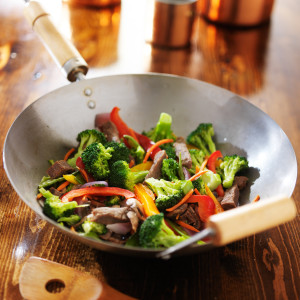Mama G. (aka Leann Grunwald) woks up a healthy stir-fry dish in North Valley Magazine
Stir-fry is a fantastic, healthy cooking method because it emphasizes vegetables and places less focus on the meat and uses minimal oil. Plus, the high heat prevents more delicate nutrients from being destroyed. Oils that are used for stir-frying are generally lower in saturated fat. An entree will generally yield 350 to 400 calories per serving in contrast to a restaurant stir-fry that has triple the calories as well as a high-fat content.
I highly recommend that you invest in a flat-bottom carbon-steel wok. They are incredibly inexpensive. Often, the lesser-quality woks are pricier. I would not even bother to stir-fry without this handy tool. When cooking beef stir-fry, one of the most common mistakes is to introduce entirely too much meat into the wok. Don’t use more than 12 ounces.
Keep in mind mis en place, a French phrase that means to prepare ingredients prior to cooking and arranging in the order they are used in the dish. I’m sure you have heard this phrase; it’s critical to a successful stir-fry dish. This allows you to just cook and prevents scattered cooking. You will be so happy with the results if you prepare. Isn’t it like that with everything?
During initial sear, allow beef to sit in one place for about one minute or so without interference. Authentic Chinese is a continuous stir, but that’s because chefs are cooking on a professional range that provides more heat than our home stoves are usually capable of achieving. If you don’t allow the beef to sit and sear for a few moments, the integrity of the dish will suffer greatly.
If cooking for a large group, plan ahead and know that two or three separate batches will ensure success. I prefer to serve all guests a piping-hot entree, so I choose to have two woks going at the same time.
When slicing beef, make certain all cuts are against the grain, of equal size, and a quarter-inch thick. This is critical for tenderness as well as even cooking. Note that when using ginger, always add this to the beef marinade as opposed to directly into the oil. Ginger is a tenderizer and adds an infused flavor burst. This beautiful dish is marinated just prior to cooking.
There is nothing that compares to properly cooked stir-fry veggies. To ensure al dente, never walk away during the cooking process, even for just a few seconds to check a text, or your dish is history. Carefully monitor and watch how color changes—this will help you gauge doneness. For example, green beans will become vibrant green, carrots vibrant orange. The best test is to take a nibble as you go.
Well, I have bestowed on you some beautiful cooking wisdom. I believe it’s the little secrets, tips, and tools that we use in cooking that make a dish so successful.
Asian Beef and Peppers
Serves 4
Ingredients
12 ounces flank steak, trimmed
1 Tbs. ginger, peeled
2 tsp. cornstarch
2 tsp. plus 1 Tbs. soy sauce
2 tsp. plus 1 Tbs. rice wine
1/2 tsp. sea salt
2 tsp. plus 2 Tbs. peanut oil
1 Tbs. Heinz ketchup
1 Tbs. hoisin sauce
3 tsp. Sriracha sauce
4 garlic cloves, smashed
1 cup, thinly sliced carrots
1 cup thinly slice portobello mushrooms
1 cup broccoli
2 cups red bell pepper, cut into thin, equal strips
2 scallions, halved lengthwise and cut into 1-inch pieces
Directions
Cut the flank steak with the grain into two strips, 1½ inches wide. Cut each strip across the grain into slices 1/4 inch thick. Place in a shallow bowl, add ginger, cornstarch, 2 teaspoons soy sauce, 2 teaspoons rice wine, and ¼ teaspoon of the salt and sugar, and mix well. Stir in the 2 teaspoons oil. In a small bowl, combine the ketchup, hoisin sauce, Sriracha sauce, the remaining 1 tablespoon of soy sauce, and 1 tablespoon rice wine.
Related posts
Leave a Comment
You must be logged in to post a comment.







